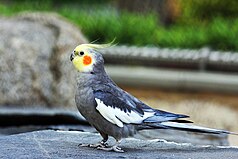Albinia National Park
| Albinia National Park | ||
|---|---|---|
| Cockatiels ( Nymphicus hollandicus ) | ||
|
|
||
| Location: | Queensland , Australia | |
| Specialty: | Grasslands | |
| Next city: | 100 kilometer (s) from Emerald | |
| Surface: | 73.60 km² | |
| Founding: | 2008 | |
| Flute bird ( Gymnorhina tibicen ) | ||
The Albinia National Park (English Albinia National Park ) is a 73.5 square kilometer national park in Queensland , Australia . It is named after Albinia Downs, a farm north of the park. It belongs to the Brigalow Belt South bioregion .
location
It is located in the Fitzroy region about 570 kilometers northwest of Brisbane and 240 kilometers west of Rockhampton . The closest city is Emerald . From here you can reach the park on the Dawson Highway south. About 50 kilometers after the town of Springsure and 15 kilometers before Rolleston , the highway runs parallel to the northern border of the national park for 12 kilometers. There are no roads or visitor facilities in the park itself.
The Carnarvon , Nuga Nuga , Expedition and Humboldt national parks are also in the vicinity .
Flora and fauna
Albinia National Park protects a grassy landscape in the central highlands of Queensland. Grasslands comes on fertile clay soils of tertiary basalt and slate from the Perm before, which meant that these areas were used for cultivation and animal husbandry. The natural grasslands are usually up to one meter high and form a relatively dense layer of grass.
In the past, Queensland Blue Grass ( Dichanthium sericeum ) was the most widespread grass species, but it has been replaced by White Speargrass ( Aristida leptopoda ), Native Millet ( Panicum decompositum ) and Yabila Grass ( Panicum queenslandicum ).
The grassland is an important habitat for numerous animals, including narrow-footed pouch mice , flat-head pouch mice , the southern large -winged marsupial and the koala , as well as reptiles , amphibians and over 128 different bird species . Flute birds ( Gymnorhina tibicen ), black-throated crow's shrike ( Cracticus nigrogularis ), cockatiels ( Nymphicus hollandicus ) and the red-backed easel ( Malurus melanocephalus ) are particularly common in the park .
North of Emerald, the Peak Range National Park protects a further 720 hectares of the pristine grassy landscape in central Queensland.
Web links
- Albinia National Park , Queensland Government website, WetlandInfo (English)
Individual evidence
- ↑ a b Terrestrial Protected Areas by IUCN Category in Queensland (2014). Department of the Environment, Australian Government, accessed August 17, 2015 .
- ^ Albinia National Park. OpenStreetMap , accessed August 17, 2015 .
- ↑ a b Advice to the Minister for the Environment, Heritage and the Arts from the Threatened Species Scientific Committee (the Committee) on an Amendment to the list of Threatened Ecological Communities under the Environment Protection and Biodiversity Conservation Act 1999 (EPBC Act). (PDF; 122 kB) Accessed January 1, 2019 .
- ↑ a b Species lists. Department of the Environment, Australian Government, accessed August 17, 2015 .


